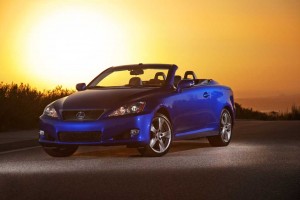
Can Lexus inject some passion into the brand with models like the 2010 IS250C convertible?
Let’s face it, when you think about passionate car brands, Lexus is not the first to come to mind. Among luxury marques, Ferrari, BMW, possibly Audi will immediately pop into your head. Toyota’s luxury division is all about quality, reliability and, well, the brand you think of for folks who like reliable automotive appliances.
At least, that’s how things were for much of the maker’s first two decades. The flagship Lexus LS is a perfect example. It’s loaded with luxury features and routinely wins the quality awards, but it’s certainly no 7-Series when it comes to spirited driving.
Enter the IS, the entry-luxury sedan first launched in 2000, and updated five years later. It’s steadily morphing into a car that, while not quite yet the match of a 3-er, certainly can be described as “spirited.” Last year’s launch of the V-8-powered IS-F boosted the nameplate’s bona fides. Now comes the 2010 Lexus IS250C and IS350C convertibles.
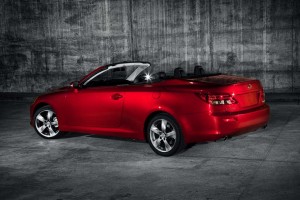
Lexus will launch the 2010 ISC line-up, later this month, for a base price of $38,490.
We spent several days along the southern coast of Los Angeles testing out the new convertibles and if this is any indication of where Lexus is heading, it may be making all the right moves as it begins its third decade. While the ISC twins boast the sort of refinement and apparent quality one expects out of this marque, they’re likely to win over a lot of new fans – not just to Lexus but to the idea of everyday, top-down driving.
If you’re already familiar with the Lexus IS, the look of the IS250C and IS350C won’t catch you entirely by surprise, but with the folding hardtop in place, it is a bit different in appearance than the earlier versions of the IS line. And so you’d expect, considering the only piece of sheet metal shared with the coupe is the hood. Even the front fascia is revised slightly, with deeper-set fog lamps.
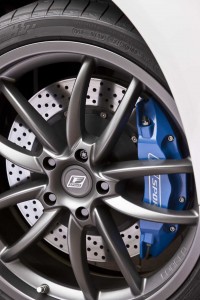
The 2010 Lexus IS250C and IS350C convertibles can be dressed up with a variety of new F-Sport accessories.
(You can dress things up even more by ticking the boxes for a variety of new F-Sport accessories, from wheels to shifter handles, borrowed from the IS-F line.)
The rear deck lid is a bit taller, and, nose-to-tail, the Cabrio siblings measure 182.5 inches, about 2.2 inches longer than the conventional sedan. The added length is in the rear, explains Paul Wiliamsen, of the University of Toyota, “so our stylists could get the look they wanted and keep a reasonable trunk.”
The 3-piece top uses an impressive 15 motors and 37 sensors to enact its origami act in just 20 seconds. With it tucked away, there’s enough space in the trunk for a couple duffel bags or a smallish set of golf clubs. Pack tight and you could get away for a cozy weekend, even without dumping luggage in the rear seat. And those two back buckets could actually accommodate a couple adults, by the way, thanks to those extra two inches of body length.
The IS line, on the whole, is part of the unusual Lexus strategy of offering two entry-luxury models. (There’ll be a third offering in this segment when the new HS250h hybrid sedan reaches market, later this year.) As such, the interior doesn’t have quite the lavish look of the mid-level GS or high-line LS models, but the IS is nonetheless well-appointed for its segment. The sloping dashboard is a bit too much plastic for our taste, but the low-gloss finish and tasteful graining help, as do the little bits of “wood” trim throughout the cabin.
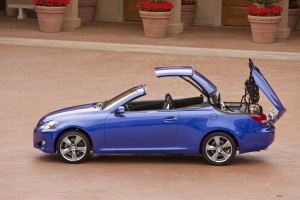
The 3-piece metal roof of the 2010 Lexus IS250C and IS350C will fold up or down in just 20 seconds.
Controls are generally well-placed and the gauges are attractive and easy to read. Our one big complaint – and it is a significant one – is with the big LCD monitor at the top of the center stack. With the top up, the touchscreen is easy to use and boasts phenomenal resolution, but when driving al fresco, it completely washes out, even on a cloudy coastal morning. That makes it near impossible to follow the system’s state-of-the-art mapping display, or to use the audio system. Too bad, there, as we wound up giving up trying to find some music after plugging in our iPhone.
Speaking of music, even the base audio system has been upgraded, on the IS convertible, and automatically adjusts to the change in conditions when the top is up-or-down. (So does the climate control system, by the way.) Given a few extra bucks in our pocket, we’d immediately opt for the top-line Mark Levinson audio package, which delivers 270 watts of music through a 12-speaker, 5.1-channel surround sound configuration. The 2010 Lexus IS convertible also introduces Bluetooth audio for those new MP3 players and phones that offer this feature.
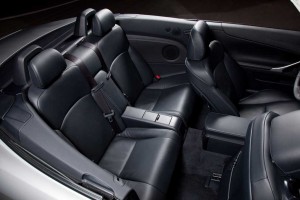
Adding 2 inches to the overall length of the IS delivers a functional trunk and a usable back seat.
As you’d expect from Lexus, there’s an alphabet soup of safety systems: ABS brakes, BA – or brake assist – TRAC traction and stability control, and so on. There are also front, knee and seat airbags and special gel-filled energy-absorbing cells for back seat passengers. With the ’10 convertible, Lexus also introduces HAC, or Hill-start Assist Control. If you’re nose up on a steep incline, simply press the brake pedal a bit harder than normal and the car will hold in place, for a few seconds, without rolling backwards.
There are a plenty of accessories available, if you’re willing to nudge up from the base $38,490 for the Lexus IS250C and $43,940 for the Lexus IS350C. (Add another $875 for delivery and destination, or D&D, charges.) There’s everything from Pre-Collision, which can help sense and respond to an imminent accident, to radar-guided cruise to 18-inch wheels and a backup camera.
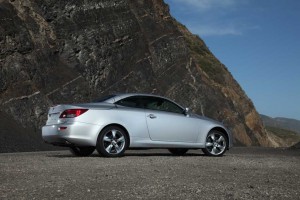
Only a single piece of sheet metal -- the hood -- is shared between the Lexus IS and the new ISC convertible line.
The heart of the IS250C is a new, Direct-Injection 2.5-liter V-6 that makes a peppy 204 horsepower and 185 pound-feet of torque. It can be mated to either a 6-speed automatic or a 6-speed stick. We spent several hours driving the manual package and it’s a lot more fun than the numbers might suggest. In fact, despite the added 340 pounds of the foldaway hardtop, the “base” IS convertible is a surprisingly fun-to-drive automobile. It’s quick off the light and with the various F-Sport options available, it could prove to be the real tuner car in the series. At the same time, it’s a good offering for the mileage-minded buyer, delivering 21 mpg around town and 29 on the highway.
For that extra $5,500, the 2010 Lexus IS350C delivers an assortment of added standard features – and a 3.5-liter V-6 that boasts an unusual Direct-and-Port injection system. Offered only with a 6-speed automatic, it makes an impressive 306 hp and 277 lb-feet of torque. It’s a real serious performer and, on the highway, will get you into extra-legal territory far faster than you might expect.
The suspension of the convertible has been tweaked, but maintains the multi-link front and double-wishbone rear layout. In sharp corners, the convertible surprised us with how flat a turn it could cut. But around town, the suspension proved quite effective at soaking up the bumps, as well. Steering is precise and offers just the right amount of boost without eliminating road feel.
Is the IS convertible a match for the BMW 3-cabrio? It still doesn’t match the passionate feel of the Bavarian offering. It’s just not quite up to the handling and throttle responsiveness of the Bimmer. But it comes far closer than you might expect from a convertible bearing the Lexus badge. And when you consider that you can get into the up-line LS350C for about what you’d pay for a base BMW convertible, there are going to be a number of potential buyers who will, at the very least, take a serious pause.
The new IS cabriolet is a markedly better, more mainstream exercise than the quirky and ungainly SC convertible. If this is the direction Lexus plans to continue moving in, the 2010 IS250C and IS350C siblings are definitely worth a closer look. They’re fun, affordable and they’ll be rolling, top-down, into your nearest Lexus showroom later this month.
To find out more about where Lexus is evolving, click here for a new Q&A with Lexus General Manager Mark Templin.

I would like to buy a new IS250C which is not sold
in Europe. It doesn’t cost much today to ship a
new car from the States to Europe – say to Hamburg
or Rotterdam. I would pay by irrevocable confirmed Letter of Credit. I would need an original Certificate of Conformity issued by Lexus
stating the car is approved for Europe, particularly Italy
Hi, Anthony,
I wish I could assist, but this is an area I have zero direct experience in. There are numerous gray market distributors, however, and a little time on a search engine should get the process started. I just did a quick check, using the search term: “import American cars to europe,” and among others, these results came up:
TopCargo.com, which specializes in vehicle logistics “anywhere”; and
NAATA.org, which represents those who handle auto exports around the world.
That’s just a partial list of what will come up on the first page alone.
Personally, I’d connect with several potential vendors and I would likely contact my national government to see what rules apply, whether tax, homologation (converting a vehicle to local safety, emissions and other rules), and so forth. Also check on matters such as liability and insurance. A good vendor should be able to handle all these matters, but it doesn’t hurt to know what you’ll face ahead of time.
Good luck.
Paul A. Eisenstein
Bureau Chief, TheDetroitBureau.com